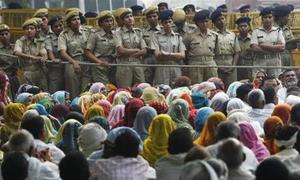Nuclear mattersOpposition to nuclear power grows in India
Opponents of nuclear power in India have received a major boost following the continuing nuclear crisis in Japan; the Indian government has planned an aggressive push to develop thirty-nine new nuclear power plants; by 2050, the government hopes to generate 25 percent of the country’s electricity with nuclear power; as a result of the events at Japan’s Fukushima Daiichi nuclear plant, Indian scientists, politicians, and residents have become increasingly opposed to the construction of new nuclear plants; critics cite safety concerns and cleaner alternatives as reasons for their opposition; India faces a real need for power, approximately 40 percent of the country is not connected to the electrical grid and most major cities do not have reliable power twenty-four hours a day

Protest against nuclear power in India // Source: trust.org
Opponents of nuclear power in India have received a major boost following the continuing nuclear crisis in Japan.
To fuel its need for energy, the Indian government has planned an aggressive push to develop thirty-nine new nuclear power plants in addition to the five that it is already building. By 2050, the government hopes to generate 25 percent of the country’s electricity with nuclear power. Currently, India has twenty nuclear reactors that produce about 3 percent of the nation’s electricity. But, as a result of the events at Japan’s Fukushima Daiichi nuclear plant, Indian scientists, politicians, and residents have become increasingly opposed to the construction of new nuclear plants.
In an open letter, a group of 50 Indian scientists, academics, and activists urged the government to impose a moratorium on all new nuclear projects.
The letter said, “The Japanese nuclear crisis is a wake-up call for India.”
In particular, opposition to the planned construction of six nuclear reactors in Madban, India has gained more momentum. Local farmers have been joined by engineers, scientists, academics and former government officials in their efforts to halt construction.
The opposition is quick to point out that Madban has been hit by nearly 100 earthquakes from 1985 to 2005, but state officials counter that the quakes were mostly minor and that the plant would be situated high atop the cliffs protecting it against tsunamis.
If completed, the facility in Madban would be the world’s largest nuclear power plant.
While many may oppose nuclear power, government officials say that India cannot meet its energy needs without nuclear power.
As India’s economy continues to grow, business and residents have been subject to routine power outages. Approximately 40 percent of the country’s 1.2 billion people are not connected to the electrical grid and most major cities, not including Mumbai and New Delhi, do not have reliable power twenty-four hours a day. This has forced many industries to rely on diesel generators to keep their businesses running.
In addition, India currently obtains 70 percent of its oil from overseas and in recent years has begun to import increasing amounts of coal.
Proponents of nuclear dismiss security concerns, stating that the Fukushima Daiichi reactors are forty years old and safety measures have improved significantly since then.
Anil Kakodkar, the former chairman of India’s Atomic Energy Commission, said, “Clearly Fukushima was an unprecedented natural event, but the facilities, particularly nuclear facilities, have to be designed to meet such extreme situations. Ultimately, this will settle down, but we can’t ignore nuclear power in terms of meeting the power needs of the world.”
But Adinarayan Gopalakrishnan, the former chairman of India’s Atomic Energy Regulatory Board, is not convinced.
Gopalakrishnan is particularly concerned about the reactor models chosen to be installed at the Madban site. He believes that the new Areva designed reactors, dubbed EPR, are unproven.
The new model is a pressurized water reactor, which the company says is a highly advanced model. But, so far, the company’s first installations in France and Finland were stalled due to safety problems.
Gopalakrishnan said, “In view of the vast nuclear devastation we are observing in Japan, I would strongly urge the government not to proceed with the Jaitapur project with purchase of EPRs from France or any other import of nuclear reactors.”
Some believe that India’s energy needs can be met from a variety of sources and reforms.
Currently more than 30 percent of India’s electricity is lost during the transmission and distribution process. Much of it is lost due to the inefficient transmission systems, but the vast majority is believed to be siphoned off by corrupt officials. Minimizing the theft of electricity and upgrading the electrical grid alone would offer a large boost without having to build any new power facilities.
Other efforts include investing in renewable energy projects like hydroelectric, wind, biomass, and solar power. In 2009, the country launched its National Solar Mission with a goal of generating twenty gigawatts of solar power by 2022.
But observers believe that these goals are too ambitious to be realistic. India currently only generates 6 gigawatts of power from solar energy.
No clear answers have emerged and no policy decisions have been made, so in the meantime, the battle to shape India’s energy future will continue to rage on.
Much to the dismay of those opposed to nuclear power, atomic energy is likely to play some role in India’s future given how prominently it is featured in the current government’s agenda.
Prime Minister Manmohan Singh has been deeply committed to nuclear energy given that in 2008 he staked his government’s survival on a hotly debated civil nuclear deal with the United States.
As a result of the agreement, India is now allowed to purchase nuclear technology and import uranium fuel from Western nations, even though the country has refused to sign the Nuclear Nonproliferation Treaty.
